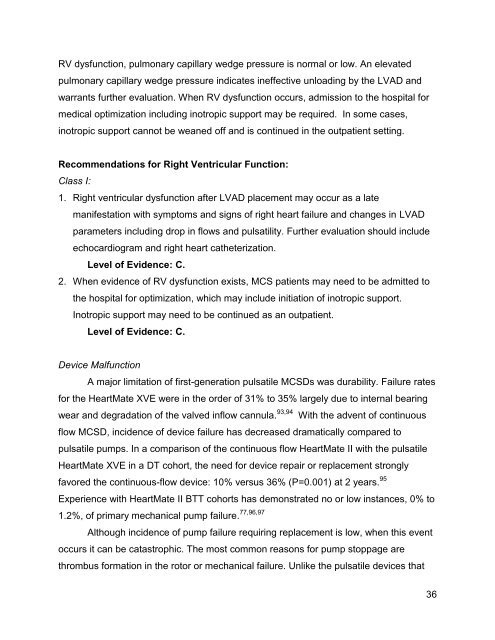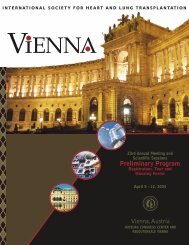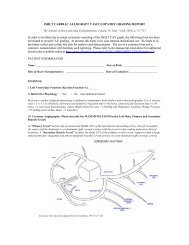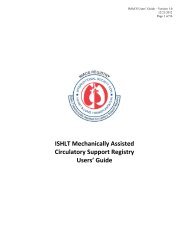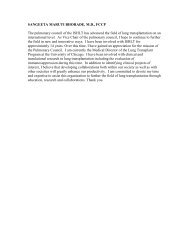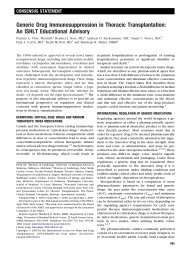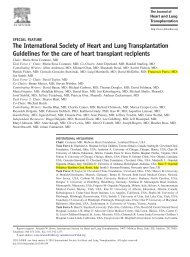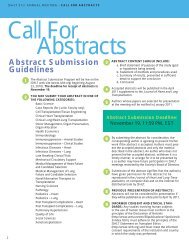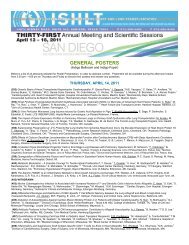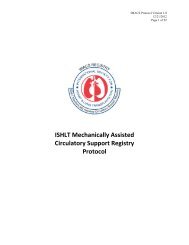Task Force 4: Inpatient Management of Patients with MCSD - The ...
Task Force 4: Inpatient Management of Patients with MCSD - The ...
Task Force 4: Inpatient Management of Patients with MCSD - The ...
You also want an ePaper? Increase the reach of your titles
YUMPU automatically turns print PDFs into web optimized ePapers that Google loves.
RV dysfunction, pulmonary capillary wedge pressure is normal or low. An elevated<br />
pulmonary capillary wedge pressure indicates ineffective unloading by the LVAD and<br />
warrants further evaluation. When RV dysfunction occurs, admission to the hospital for<br />
medical optimization including inotropic support may be required. In some cases,<br />
inotropic support cannot be weaned <strong>of</strong>f and is continued in the outpatient setting.<br />
Recommendations for Right Ventricular Function:<br />
Class I:<br />
1. Right ventricular dysfunction after LVAD placement may occur as a late<br />
manifestation <strong>with</strong> symptoms and signs <strong>of</strong> right heart failure and changes in LVAD<br />
parameters including drop in flows and pulsatility. Further evaluation should include<br />
echocardiogram and right heart catheterization.<br />
Level <strong>of</strong> Evidence: C.<br />
2. When evidence <strong>of</strong> RV dysfunction exists, MCS patients may need to be admitted to<br />
the hospital for optimization, which may include initiation <strong>of</strong> inotropic support.<br />
Inotropic support may need to be continued as an outpatient.<br />
Level <strong>of</strong> Evidence: C.<br />
Device Malfunction<br />
A major limitation <strong>of</strong> first-generation pulsatile <strong>MCSD</strong>s was durability. Failure rates<br />
for the HeartMate XVE were in the order <strong>of</strong> 31% to 35% largely due to internal bearing<br />
wear and degradation <strong>of</strong> the valved inflow cannula. 93,94 With the advent <strong>of</strong> continuous<br />
flow <strong>MCSD</strong>, incidence <strong>of</strong> device failure has decreased dramatically compared to<br />
pulsatile pumps. In a comparison <strong>of</strong> the continuous flow HeartMate II <strong>with</strong> the pulsatile<br />
HeartMate XVE in a DT cohort, the need for device repair or replacement strongly<br />
favored the continuous-flow device: 10% versus 36% (P=0.001) at 2 years. 95<br />
Experience <strong>with</strong> HeartMate II BTT cohorts has demonstrated no or low instances, 0% to<br />
1.2%, <strong>of</strong> primary mechanical pump failure. 77,96,97<br />
Although incidence <strong>of</strong> pump failure requiring replacement is low, when this event<br />
occurs it can be catastrophic. <strong>The</strong> most common reasons for pump stoppage are<br />
thrombus formation in the rotor or mechanical failure. Unlike the pulsatile devices that<br />
36


